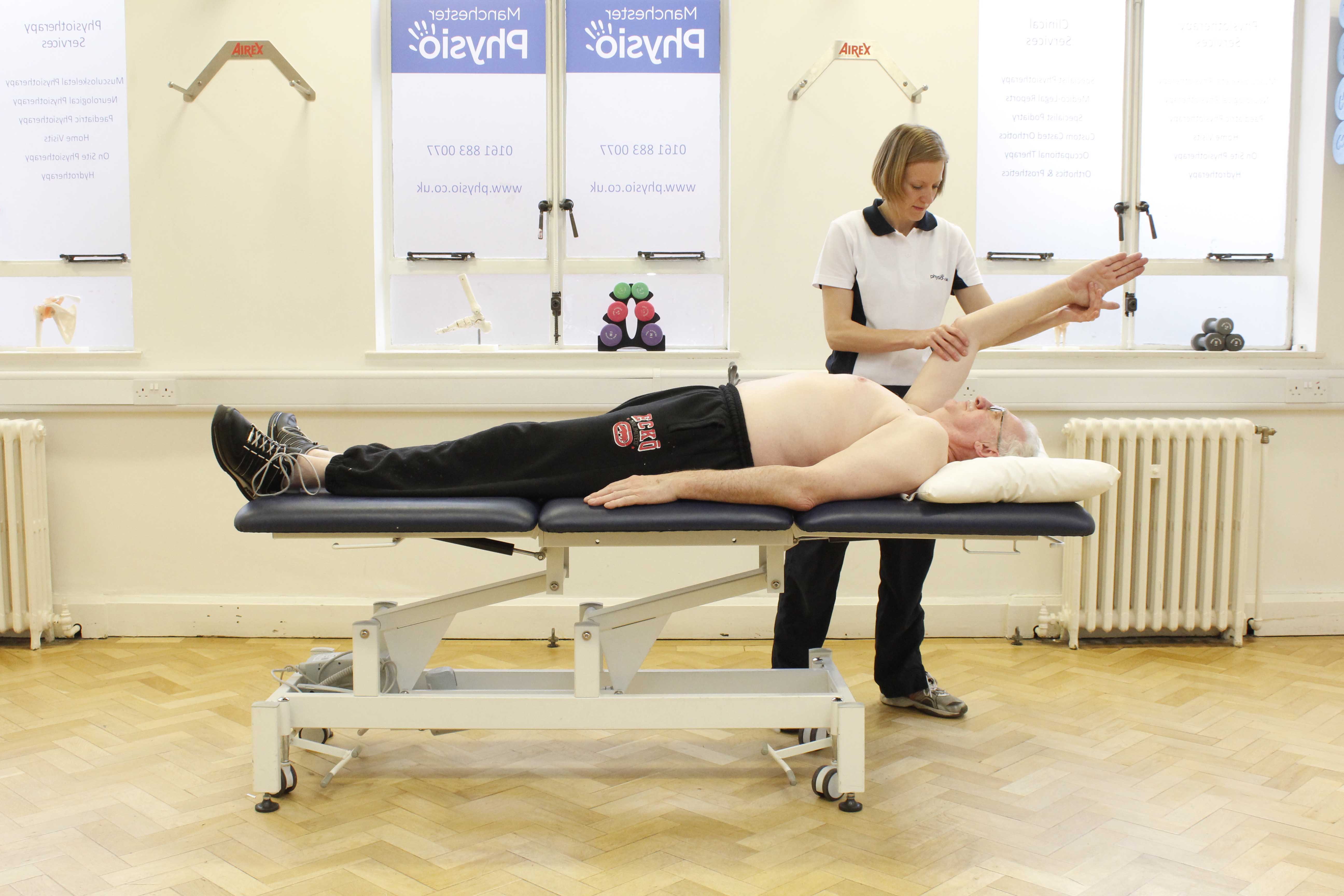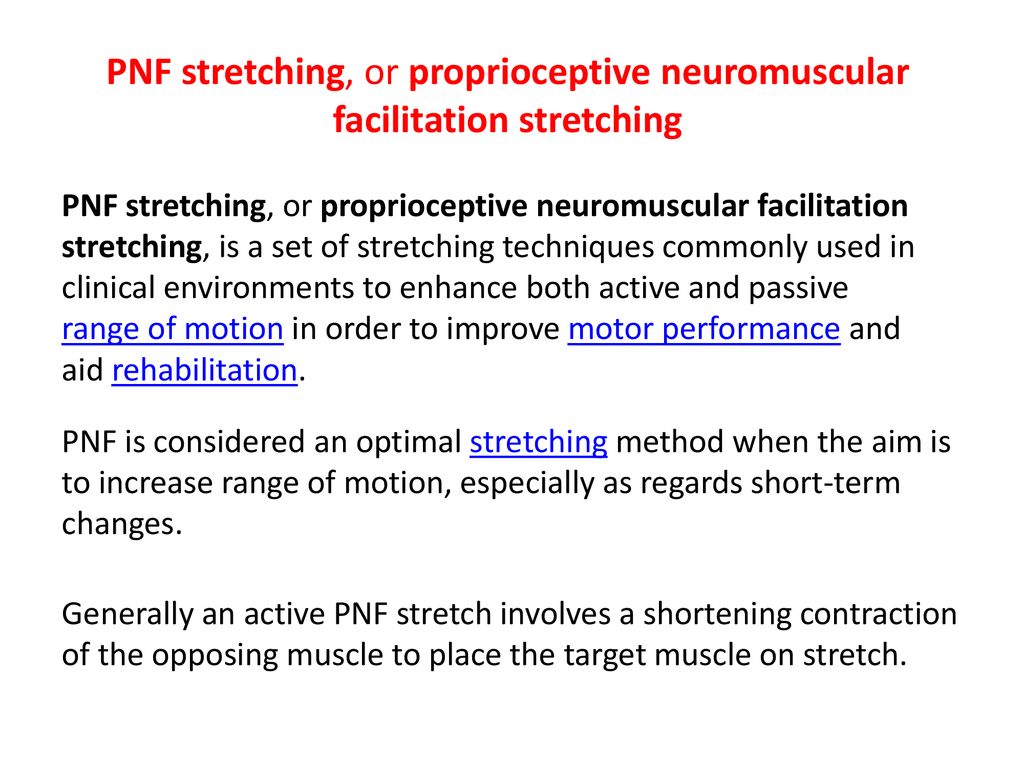9 Pnf Proprioceptive Neuromuscular Facilitation Uses Which of the Following
Lucas and Koslow 1984. Involves active participation.

A Participant Position During Proprioceptive Neuromuscular Download Scientific Diagram
PNF relies on handling by the therapist in order to provide more normal sensory input so that the patient may move in more coordinated patterns.

. PNF is a progressive stretch involving muscle contraction and relaxation. Neuromuscular - Nerves and muscles. Proprioceptive neuromuscular facilitation is exercise based on the principles of functional human anatomy and neurophysiology.
Proprioceptive neuromuscular facilitation PNF is a widely used intervention in the rehabilitation of patients with neurological and musculoskeletal disorders 12. First course taught to OTs was in 1974 and continuing education courses are offered in PNF 1-2 week. PNF stretching was originally developed.
Several editions have been published since 1954 Current edition is proprioceptive neuromuscular facilitation. - short and concise instructions. It uses Proprioceptive Cutaneous Auditory input To produce functional improvement in motor output and can be a vital element in the rehabilitation process of sports related injuries.
Wallin et al 1985Recent research has been focused on the efficacy of the intervention on certain. The following outcome measures were used. Various authorities differ in both the methods used to achieve targeted flexibility levels and the effectiveness of certain of those modalities the technique referred to as proprioceptive neuromuscular facilitation PNF which originated in rehabilitation therapy Voss et al 1985 is widely practiced in athletic preparation and touted as.
Promotes highest level of function. PNF concept uses diagonal movements of arms legs head in all three planes just as we do in everyday activities. - very specific hand movements.
Proprioceptive Neuromuscular Facilitation PNF is a concept of treatment designed for improving the functional capabilities of people suffering from neurological and traumatic conditions. Cervicalcaudal head to feet and proximoldistal midline to extremities. - Sensory receptors concerning movement and positon.
It involves a very small amount of resistance. Tap again to see term. Proprioceptive neuromuscular facilitation PNF uses spiral or diagonal movement patterns to indirectly facilitate movement with the.
As an alternative strategy to stimulate active breathing associated with stretching of the antero-posterior cranio-caudal and latero-lateral diameters of the trunk respiratory exercises following the principles of proprioceptive neuromuscular facilitation PNF have gained more interest for the treatment of patients with stroke 23 24. - want to increase strength or improve relaxation by enhancing overflow from the stronger to the weaker muscles. Click again to see term.
Proprioceptive neuromuscular facilitation PNF is a stretching technique that can improve your range of motion. Aisometric phase Brelaxation phase Cstatic stretch phase Dall the above Accessibility. Parkinson disease PD is a chronic and degenerative disorder of the central nervous system of idiopathic etiology.
Flexibility is influenced by which of the following. Static stretch phase D. Diagonal movement patterns with the limbs and trunk to promote functional movement diagonals are a normal part of movement normal motor development pattern.
It is aimed to achieve the highest level of function in the person by using a positive approach. This leads to faster recovery pain reducing muscle strength and greater mobility when compared to other stretching and mobility methods. PNF stretching is one of the most effective forms of stretching for improving flexibility and increasing range of motion.
Facilitation - That which makes things easier. It can cause more muscle soreness than other types of stretching. Integration of motor control and learning.
For each give an example of a stretch utilizing the technique. 1278 It uses proprioceptive cutaneous and auditory input to produce functional improvement in motor output and it can be a vital element in the rehabilitation process of many conditions and injuries. PNF patterns are more concerned with specific muscle action as opposed to mass body movements.
Which one of the following statements about proprioceptive neuromuscular facilitation PNF is most accurate. Pnf proprioceptive neuromuscular facilitation uses. PNF Proprioceptive Neuromuscular Facilitation uses which of the following.
It involves bouncing repetitive movements. All the above Accessibility. Proprioceptive Neuromuscular Facilitation PNF is a stretching technique utilized to improve muscle elasticity and has been shown to have a positive effect on active and passive range of motions Funk et al 2003.
The following are commonly used in a more eclectic manner to provide compensatory techniques during the course of recovery with the goal of improving function. Your physiotherapist will gently stretch the muscle and you will resist the stretch by contracting the muscle for about 5 seconds. Proprioceptive Neuromuscular Facilitation PNF is a more advanced form of flexibility training which involves both the stretching and contracting of the muscle group being targeted.
Proprioceptive Neuromuscular Facilitation PNF Diagonals are a normal part of movement. PNF can restore or enhance postural responses of normal patterns of motion. Proprioceptive neuromuscular facilitation PNF is an approach to therapeutic exercise based on the principles of functional human anatomy and neurophysiology.
However it is not clear which one is superior. It is the most common and practical type of stretching. Therapist must first estimate the condition do some measures and test develop a therapy.
A combination of bilateral upper extremity asymmetrical extensor patterns performed as a closed-chain activity. Many therapists use PNF to help people regain their. PNF Proprioceptive Neuromuscular Facilitation uses which of the following.
The effect of proprioceptive neuromuscular facilitation PNF and static stretching on flexibility has been demonstrated. PNF is a form of stretching designed to increase flexibility of muscles and increase range of movement. Which of the following is NOT true concerning PNF patterns.
Your physiotherapist will indicate. Define and explain the differences among static stretching ballistic stretching dynamic stretching proprioceptive neuromuscular facilitation passive stretching and active stretching. Tap card to see definition.
Terms in this set 48 PNF Definition and Philosophy. PNF patterns are more concerned with mass body movements as opposed to specific muscle actions b. Patterns and techniques 3rd ed 1985.
Methods of promoting the response of neuromuscular mechanism through stimulation of the propioceptors. In this disease there is a reduction of dopamine in the nigrostriatal pathway which is caused by the death of neurons of the substantia nigra in the midbrain and responsible for eye movement motor planning reward seeking learning and.
Pnf Stretching Proprioceptive Neuromuscular Facilitation Bodywork Santa Barbara Goleta Ca Santa Barbara Deep Tissue Riktr Pro Massage Nicola Lmt

Proprioceptive Neuromuscular Facilitation Pnf Physiotherapy Treatments Physio Co Uk

Proprioceptive Neuromuscular Facilitation Pnf Ppt Download
Pnf Stretching Proprioceptive Neuromuscular Facilitation Bodywork Santa Barbara Goleta Ca Santa Barbara Deep Tissue Riktr Pro Massage Nicola Lmt
Comments
Post a Comment